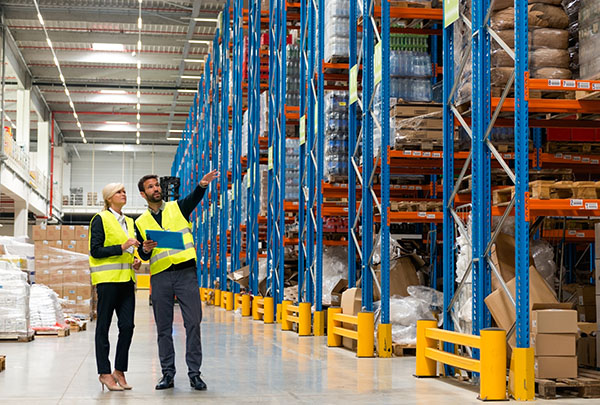When Pallet Rack Expertise is Critical
How to determine when you need advice on your project

Pallet rack is the most common storage equipment you will find in most warehouses and industrial storage applications. On its face, rack is simple to specify, purchase and install, but there are situations where you should consult an expert involving space efficiency, seismic zones, safety, difficult loads and other situations. Let’s look into some situations where professional help is necessary.
You can buy pallet racks online. We sell them that way every day. You can buy them from any number of sources, and for many applications, that’s fine. If it’s critical that your rack project succeeds, a racking expert is a great investment. Here are some situations where you should seek professional assistance:
#1: You’re in a seismic zone
In seismic zones, off-the-shelf rack is often unsafe. You’ll need to specify the right baseplates and connectors to ensure your rack is both safe and code-compliant. According to Steel King’s Arlin Keck, “ordering quick-ship pallet racks should be limited to use with non-flammable, non-hazardous product stored inside buildings in low-risk seismic regions.”
Also, remember that seismic regions aren’t static. What was not rated for seismic racks a decade ago may require them today.
To understand whether you need seismic racks, you can research local codes or employ a material handling specialist who has experience in the area. 42 U.S. states have the potential for seismic activity. If you design your rack system to comply with local building codes, you should be fine. A knowledgeable rack company can help you do this quickly.
Read our interview with Arlin Keck of Steel King on Seismic Issues and Pallet Racks
#2: You need to maximize space
When space is critical, a rack expert can help you with ways to squeeze the very most. If you are laying out an entirely new storage area, it’s a bit easier than reconfiguring an existing one, but either is possible. A knowledgeable rack expert knows the ways to optimize space that blends layout tactics, rack types, storage strategies and more.
Space efficiency suggestions

- Rack tunnels: Rack tunnels are cross-aisles through a rack system. They’re created by removing a beam level, which allows forklifts and people to travel in the “tunnel” left behind. You can continue to store pallets on the positions above the passage. The net space is gained by increasing the overall storage density of a rack system.
- Use more vertical space: If you aren’t using the full vertical space available to you, you can add significant numbers of pallets to a storage area by installing taller uprights. Where you may need assistance in establishing an effective height, which is called the clear ceiling height. This is basically the space between the bottom of your lowest obstruction (things like sprinkler heads, lights, ducts, or struts) and the floor. You must leave enough space for the height of your load plus the room needed to load and unload it from that top-level beam.

- Specify the right size frames: Sometimes we see 48″ deep uprights where 42″ would do. Across a facility, that difference can be an extra aisle or two. Make sure you need a deeper rack before you specify it.
- Utilize double-deep racks: Double deep racks are still selective racks but use two back-to-back racks and deep reach lift trucks to add last-in, first-out picking positions. If you have certain loads that don’t depend on inventory rotation, or that are picked relatively quickly, double-deep is a good way to concentrate storage.
- Narrow your aisles: As we have discussed, adequate aisle space is critical for safe operations, as drivers have a greater chance of rack collisions when aisles are narrow. However, there are times when you can safely add space by reducing aisle widths.
- Make use of high-density systems such as pushback, drive-in, or pallet flow systems. These racks can be mixed with selective racks for space-optimized storage in many operations where selectivity can be reduced to add storage slots.
- Deploy a pallet shuttle. Electric pallet shuttles travel on rails inside a storage channel of a high-density rack system. They let you group products by “channels” rather than lanes, as in a pallet flow application. Because the shuttle travels and can deposit or pick a pallet deep in the system, it reduces space usage while also cutting down on forklift traffic. This is also a safety upgrade. This “compacts” space in a warehouse very efficiently.
#3: You’re mixing new rack and old racking
If you are reworking your current facility, there is a good chance you may be adding on to an existing system. That’s not unusual, but adding racks that aren’t the same manufacturer, design or capacity can get tricky. Many companies like the value of used racks, and that is fine so long as you fully understand what you are getting, where it’s been used, and how.
A qualified expert can help you understand these factors and how to mitigate the risks of mixed loads and rack types.
#4: You want to store a very tall, very heavy or unusual load
Because capacities for pallet rack are not straightforward, storage of unusually large, heavy, bulky or other challenging loads necessitates help from a rack pro.
Tall loads and how they complicate capacity

Pallet rack capacity is simple, but can also involve some calculations for safe storage when the load is odd-shape, and tall loads are the most frequent issue. Pallet rack beam capacity is very simple: If the beam says it can bear 5,000 pounds, that’s its true capacity (assuming you load and assemble it right, and that you don’t have uneven loads that stress any particular point). But when it comes to uprights, load characteristics change the capacity of the rack system.
For instance, a very tall load reduces capacity because it reduces the number of horizontal beams that tie the frames together. Imagine a 20′ tall upright that holds loads that are 48″ tall, plus the pallet height. Including the floor and top beam, you might have five or even six beam levels on the rack. If the load changes to, say, a 60″ height, and you remove a level, the entire rack structure is weakened and the capacity reduced. The limiting factor is called the unsupported span, which is the tallest space between beams.
What about odd-shaped loads?
Uneven weights: Anything that concentrates weight on one side of a load won’t be standard. Once a load is unevenly distributed, it’s going to challenge any rack. These calculations can get tricky, so if you have a load that is light on one side and heavy on another, consult a professional. Pallet racks can be configured to handle these loads, but all factors need to be examined and specified.
Long or bulky loads: You would usually store most long loads on cantilever racks, but there are situations where they may be stored on pallet rack. If you need to use pallet rack for this type of long items, that may require specific help on how to balance loads, sizes and rack types.
Read more: Pallet Rack Storage Ideas for Difficult Loads and Situations
Extremely heavy loads: Very heavy loads, such as dies, motors, liquids and metals almost always require specification assistance. These loads can be problematic if the right components and loading strategy isn’t utilized. Usually, they will require structural, bolted rack as opposed to roll-form racks. You’ll also need to understand how much weight these loads distribute across which parts of the rack. We always recommend specification assistance for these types of load challenges.
#5: You have safety concerns
And you should always have safety concerns!
Most rack safety issues result from poor specification and loading practices. If the rack isn’t capable of handling the loads you place on it, it poses an imminent danger to those who work around it — collapses, pallet falls and other issues that endanger warehouse workers could all occur. A rack expert can help you navigate around the safety issues that are inherent to storing multiple levels of heavy loads above aisles where people work.
#6: You’re not sure exactly what you need
Anytime you aren’t sure what fits your needs, talk to someone who can help you layout the rack, spec it right and ensure you are going to get exactly what you are after. There are times you will want to do things like mix pallet and carton flow into the same footprint or build out storage for shifting SKU types. Specific help on these issues is always worth it.
What does an expert bring to the table?
Rack experts usually have worked in the industry for a time period and have seen the applications, issues and complications. They will understand layout, how to source the right materials and how to build out a project that comes in on time and under budget. They’re up to date on new products, seismic codes and state/local building codes. Many times, a quick consultation can help you get the project right without much time investment.
Scott Stone is Cisco-Eagle's Vice President of Marketing with 35 years of experience in material handling, warehousing and industrial operations. His work is published in multiple industry journals an websites on a variety of warehousing topics. He writes about automation, warehousing, safety, manufacturing and other areas of concern for industrial operations and those who operate them.




